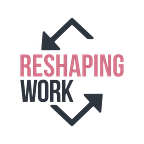Navigating safety and health in the age of AI: The Occupational Safety and Health implications of AI
Lesly Nzeusseu Kouamou — a doctoral student in Industrial & Organizational Psychology at the University of Montreal (QC, Canada). This blog is produced as a part of the Reshaping Work Fellowship Programme. The opinions and views expressed in this publication are those of the author. They do not purport to reflect the opinions or views of Reshaping Work or organisations that have supported the programme.
Artificial Intelligence (AI) is revolutionizing numerous facets of society, including workplaces and the way we work. However, the rapid development of AI and other digital technologies presents new challenges and opportunities for occupational safety and health (OSH). This article delves into the implications of AI for OSH, drawing on insights from Maurizio Curtarelli, Senior Research Project Manager at the European Agency for Safety and Health at Work (EU-OSHA), who provides an in-depth perspective on the impact of digitalization on worker safety and health.
“It is crucial to integrate OSH considerations into AI design to enhance worker well-being and prevent risks, as AI continues to reshape workplace safety.”
Workplace Safety and Health
Workplace health and safety is about identifying and preventing hazards that could lead to injury, mental and physical illness, and fatalities at work (Government of Ontario, 2022). Traditionally, this responsibility involves the proper handling of tools, adequate training, and preventive measures to mitigate risks. However, with the rise of AI, the landscape of workplace safety is evolving. AI is increasingly embedded in a wide range of digital devices and tools, transforming sectors from manufacturing and agriculture to education, healthcare, logistics, and finance. Each sector presents unique possibilities and risks, especially as European workplaces adopt AI systems for task automation, automated scheduling, performance monitoring, and working environment oversight. The question then arises: how do health provisions and safety protocols change in the age of AI? According to Curtarelli, it is crucial to integrate OSH considerations into AI design to enhance worker well-being and prevent emerging risks. As AI continues to reshape workplace safety, comprehensive research and awareness campaigns, such as the EU-OSHA’s “Safe and healthy work in the digital age” initiative, are essential to address these challenges.
In October 2023, the EU-OSHA launched the 2023–2025 Healthy Workplaces Campaign (HWC) themed “Safe and Healthy Work in the Digital Age.”
This campaign aims to raise awareness of the impact of digital technologies on work and workplaces, highlighting both the challenges and opportunities for occupational safety and health.
The HWC 2023–2025 also aims to stimulate collaboration for a safe and productive digital transformation of work
Key Risks and Challenges
According to Curtarelli, AI offers numerous OSH benefits, such as delegating repetitive and hazardous tasks to machines as well as optimizing work organization and workers’ workload. However, it also poses significant risks, including loss of autonomy (e.g., algorithms automatically allocating tasks to workers), work intensification, and increased performance pressure. Curtarelli also highlights the potential for worker isolation (e.g., lack of support), blurred boundaries between work and private life, and the need for transparent decision-making processes involving workers and their representatives. Mitigating these risks requires a human-centered approach and equal access to information, ensuring that digital technologies are used responsibly and safely.
The Role of Multi-Stakeholder Collaborations
Promoting healthy and safe workplaces in the age of AI requires collaboration among policymakers, employers, workers, and civil society. Curtarelli points to the EU-OSHA’s Healthy Workplaces campaign as a prime example of such collaboration. This initiative unites multinational companies, social partners, and media to raise awareness and promote OSH across Europe. By leveraging diverse sector involvement, the campaign fosters a culture of safety and health, benefiting both employees and employers.
Emerging Technologies and OSH
Emerging technologies such as the metaverse, virtual reality (VR), augmented reality (AR), and the Internet of Things (IoT) impact the future of workers and employers. While these technologies offer enhanced training and collaboration opportunities, they also raise concerns about data privacy and security. Curtarelli notes that prolonged use of VR and AR can lead to physical and mental health issues, emphasizing the need for comprehensive risk assessments and adherence to OSH regulations to ensure worker safety.
“As AI continues to reshape the workplace, balancing technological advancements with the safety and well-being of workers is imperative.”
Implementing AI Tools: Recommendations for Organizations
To successfully implement new AI tools in the workplace, Curtarelli advises organizations to:
- Incorporate OSH risk management into their strategies from the beginning:
Conducting comprehensive risk assessments will ensure compliance with current OSH legislation and norms.
2. Promote a human-centered design:
This means focusing on human needs and capabilities in the design and deployment of AI technology; as well as inform workers about the benefits and uses of such technology to foster transparency and acceptance.
3. Prevent Deskilling:
Organisations should provide training to maintain workers’ skills and promote lifelong learning.
4. Focus on Data Privacy and Cybersecurity:
Organisations must adhere to the latest privacy and data protection regulations, ensuring consent, transparency, and accountability towards employees.
Looking Ahead: Future Trends and Prospects
As AI continues to reshape the workplace, balancing technological advancements with the safety and well-being of workers is imperative. Through proactive risk management, continuous training, and multi-stakeholder collaboration, organizations can create a safer, healthier, and more equitable work environment in the age of AI. By addressing these key aspects, we can navigate the complexities of AI in the workplace, ensuring that technology enhances rather than endangers worker safety and health.
— — —
***
Reshaping Work Fellowship is supported by Zurich Insurance.
***
